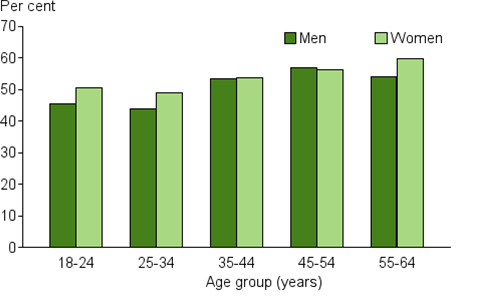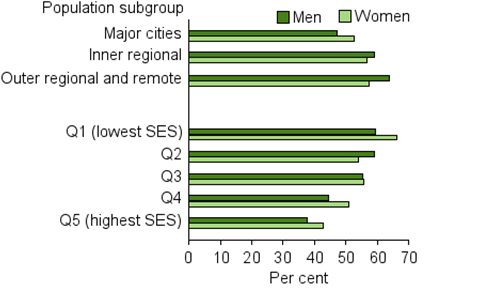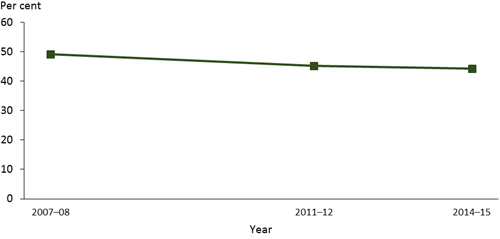Insufficient physical activity
Low levels of physical activity are a major risk factor for ill health and mortality from all causes. People who do not do sufficient physical activity have a greater risk of cardiovascular disease, type 2 diabetes and osteoporosis. Being physically active improves mental and musculoskeletal health and reduces other risk factors such as overweight and obesity, high blood pressure and high blood cholesterol.
Box 1: How is physical activity measured?
Physical activity is any bodily movement produced by the muscles which results in energy expenditure. Although most measures of physical activity focus on deliberate activity during leisure time, other forms of activity such as walking or cycling for transport, work-related activity, and daily household tasks such as housework or gardening all contribute to total physical activity.
Australia's 2014 Physical Activity and Sedentary Behaviour Guidelines recommend that adult Australians aged 18–64:
- be active on most, preferably all, days every week
- accumulate 150 to 300 minutes of moderate intensity physical activity or 75 to 150 minutes of vigorous intensity physical activity, or an equivalent combination of both moderate and vigorous activities, each week
- do muscle-strengthening activities on at least 2 days each week
- minimise the amount of time spent in prolonged sitting
- break up long periods of sitting as often as possible [1].
There are different guidelines for children and young people [2,3,4] and for older adults [5].
In the Australian Bureau of Statistics (ABS) 2014–15 National Health Survey (NHS), people were asked to report the intensity, the duration and the number of sessions spent on physical activity during the week preceding the survey [6].
Who is insufficiently active?
Based on self-reported data from the ABS 2014–15 NHS, over 1 in 2 Australian adults (56%) did not participate in sufficient physical activity.
Children and adolescents
The Australian Physical Activity Guidelines recommend children and young people (aged 5–17) accumulate at least 60 minutes of moderate to vigorous physical activity every day [3,4].
The most recent data available on physical activity in children and adolescents is the ABS 2011–12 Australian Health Survey. In 2011–12, about 3 in 10 (29%) children (aged 5–11) and less than 1 in 10 (8.2%) adolescents (aged 12–17) met the recommended amount of physical activity every day.
Toddlers and pre-schoolers (aged 2–4) spent an average of around 6 hours per day engaged in physical activity [9].
Adults (18–64 years)
For prevalence reporting we refer to ‘insufficient physical activity’ for 18–64 year olds as not completing at least 150 minutes of moderate intensity physical activity, or 75 minutes of vigorous intensity physical activity, across 5 or more sessions each week, as this closely matches the Australian Guidelines.
For trend reporting we report ‘insufficient physical activity’ based on intensity and duration only (no sessions) due to complexities relating to how physical activity data have been collected over various surveys.
Around 1 in 2 adults aged 18–64 (52%) did not participate in sufficient physical activity. Women were more likely than men to be insufficiently active (54% compared to 51%).
The rate of insufficient physical activity increases with age (Figure 1). Among 18–24 year olds, 45% of men and 51% of women were insufficiently active. For those aged 55–64, 54% of men and 60% of women were insufficiently active.
Figure 1: Prevalence of insufficient physical activity in persons aged 18–64, by sex, 2014–15

Note: Insufficient physical activity is defined as completing less than 150 minutes of moderate intensity physical activity across 5 or more sessions each week.
Source: ABS 2015. National Health Survey: First Results, 2014–15. ABS cat. no. 4364.0.55.001. Canberra: Australian Bureau of Statistics
Inequalities
Adults aged 18–64 living in Inner regional or Outer regional and remote areas are, on average, more likely to be insufficiently active (at 58% and 60% respectively) than those living in Major cities (50%) (Figure 2) [7].
The proportion of people aged 18–64 who are insufficiently active increases with socioeconomic disadvantage. In 2014–15, 60% of men and 66% of women living in the most disadvantaged areas were insufficiently active, compared with 38% of men and 43% of women living in the least disadvantaged areas.
Figure 2: Prevalence of insufficient physical activity in persons aged 18–64, by sex, by selected population characteristics, 2014–15

Notes:
- Insufficient physical activity is defined as completing less than 150 minutes of moderate intensity physical activity across 5 or more sessions each week.
- Q1–Q5 refers to area-based quintiles of socioeconomic position, based on the ABS Index of Relative Socio-Economic Disadvantage (IRSD) [8].
Source: AIHW analysis of ABS Microdata: National Health Survey, 2014–15. (see source data).
Trends in insufficient physical activity
There is currently no long-term trend data for the level of physical activity in the adult population, using the measures reported by the ABS. Data presented here are based on trends in the proportion of adults who were physically inactive, based on intensity and duration, from the last three national health surveys (see source data).
There was a slight decrease in the proportion of adults who were insufficiently active between 2007–08 and 2014–15. In 2007–08 the proportion of adults who were insufficiently active was 49%, decreasing to 44% in 2014–15 (age-standardised; Figure 3).
Figure 3: Prevalence of insufficient physical activity in persons aged 18 and over, 2007–08 to 2014–15

Notes
- Rates are age-standardised to the 2001 Australian population.
- Insufficient physical activity is captured here as completing less than 150 minutes of moderate intensity physical activity. Sessions are not included in trend analysis.
- Physical activity includes walking for fitness, recreation, or sport; walking to get to or from places; moderate exercise; and vigorous exercise recorded in the week prior to interview.
Source: ABS 2017, Customised report.
Older Australians (65 years or older)
The Australian Physical Activity Guidelines recommend older Australians (65 years and older) should be active every day in as many ways as possible, and accumulate at least 30 minutes of moderate intensity physical activity on most, preferably all days.
In this section we refer to “insufficient physical activity” for people aged 65+ as not accumulating 30 minutes of moderate intensity physical activity on at least 5 days each week [5].
In 2014–15, 3 in 4 (75%) older Australians (aged 65+) were insufficiently active. This rate was similar for males (74%) and females (77%). For women the rate of insufficient physical activity increases with age, but the same trend is not found in men. Among 65–74 year olds, 73% of men and 72% of women were insufficiently active. For those aged 85+, 79% of men and 89% of women were insufficiently active.
Source data
References
- DoH (Department of Health) 2014. Australia's physical activity and sedentary behaviour guidelines for adults (18–64 years). Canberra: Department of Health.
- DoH 2014. National physical activity recommendations for children 0–5 years. Canberra: Department of Health.
- DoH 2014. Australia's physical activity and sedentary behaviour guidelines for children (5–12 years). Canberra: Department of Health.
- DoH 2014. Australia's physical activity and sedentary behaviour guidelines for young people (13–17 years). Canberra: Department of Health.
- DoVA (Department of Veterans' Affairs) and DoH 2005. Choose health: be active—a physical activity guide for older Australians. Canberra: Commonwealth of Australia and the Repatriation Commission.
- ABS (Australian Bureau of Statistics) 2015. National Health Survey 2014–15 Questionnaire. ABS cat. no. 4363.0.55.001. Canberra: Australian Bureau of Statistics.
- ABS 2015. National Health Survey: First Results, 2014–15. ABS cat, no. 4364.0.55.001. Canberra: Australian Bureau of Statistics.
- ABS 2013. Census of Population and Housing: Socio-Economic Indexes for Areas (SEIFA). ABS cat. no. 2033.0.55.001. Canberra: Australian Bureau of Statistics.
- ABS 2013. Australian Health Survey: physical activity, 2011–12. ABS cat. no. 4364.0.55.004. Canberra: Australian Bureau of Statistics.
Further information
The physical activity guidelines referenced here are available on the Department of Health website.


